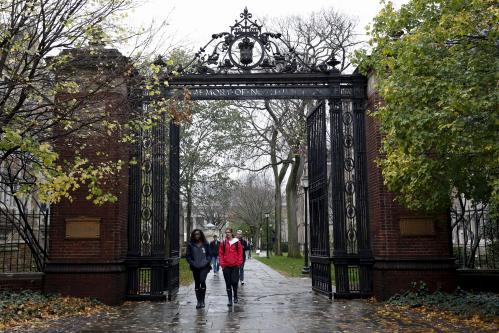In 1926, the SAT was created to give talented students, regardless of income, the chance to compete for college admission and scholarships. Nearly 100 years later, it often excludes the lower-income students it was created to help. Although the original exam was primarily aimed at economic diversity, part of its stated modern mission is to help increase racial diversity, too.
But Black and Hispanic or Latino students routinely score lower on the math section of the SAT — a likely result of generations of exclusionary housing, education, and economic policy — which too often means that, rather than reducing existing race gaps, using the test in college admissions reinforces them.
Mind the gap: SAT math scores
We investigate SAT scores by race using the College Board’s publicly available data for over 2.1 million 2020 high school graduates, with a particular focus on the math section. (This analysis builds on our earlier work on this issue from 2017, “Race gaps in SAT scores highlight inequality and hinder upward mobility.”)
The class of 2020 averaged a score of 523 of 800 on the math section of the SAT, slightly below the College Board’s college-readiness benchmark score of 530. (The College Board predicts that the average SAT test taker will earn less than a C in their first-year math course.) The average scores for Black (454) and Latino or Hispanic students (478) are significantly lower than those of white (547) and Asian students (632). The proportion of students reaching college-readiness benchmarks also differs by race. Over half (59%) of white and four-fifths of Asian test takers met the college readiness math benchmark, compared to less than a quarter of Black students and under a third of Hispanic or Latino students. As we show, there are similar patterns for English, but the gaps are not as stark.
Many colleges use SAT scores for admissions and financial aid decisions. More selective institutions require high SAT scores for entry—and there are even bigger race gaps at the top of the score distribution. Of those scoring above 700, 43% are Asian and 45% are white, compared to 6% Hispanic or Latino and 1% Black. Meanwhile, among those scoring between 300-390, 2% are Asian and 23% white, compared to 43% Hispanic or Latino and 26% Black.
The concentration of white and Asian students at the top end of the score distribution and Black and Hispanic or Latino students at the bottom of the score distribution influences the extent and type of college enrollment by race. Several studies find that Black and Hispanic or Latino students are significantly underrepresented at selective universities.
A stubborn race gap in SAT scores
The race gap in test scores is far from a new phenomenon; Asian and white students consistently outperform their Black and Hispanic or Latino peers on the math section of the SAT. In 1996, the gap between the mean Black score and the mean white score was 0.91 standard deviations; by 2020, the gap had narrowed to 0.79 standard deviations. Despite a wide range of efforts to reduce inequality, the racial gap in SAT scores has scarcely narrowed during the lifetimes of the class of 2020. In 2002, the average white student’s SAT math score was 106 points higher than the average Black student’s (533 compared to 427); by 2020, the gap narrowed to 93 points. Still, nearly a third (31%) of white test takers scored above 600 on the math portion of the SAT, compared to just 7% of Black test takers.
Rising SAT participation and college enrollment
Test score gaps shrunk by a small margin in the last two decades, but other indicators show reason for optimism: the portion of students taking the SAT rose drastically over the last two decades, outpacing the increase in the number of public high school graduates from 2000-2020. From 2000-2020, there was a 119% increase in the number of Black students taking the SAT and a 482% increase in Latino or Hispanic students, compared to a 36% and 185% increase in the number of Black and Hispanic or Latino students graduating from a public high school (reflecting, to a large extent, the increase in the size of the Hispanic population). SAT participation also rose dramatically among Asian and Pacific Islander students—136% compared to a 66% increase in the number of public high school graduates. By contrast, slightly fewer white students graduated from a public high school in 2020 than in 2000, but the number of white students taking the SAT increased by 28%.
As SAT participation gaps have shrunk, so have enrollment gaps. But significant gaps in graduation rates and test scores remain; representation is increasing, but success rates have yet to catch up. Half of Asian students and 45% of white students graduate college in 4 years compared to 21% of Black students, and 32% of Latino or Hispanic students. Default rates on student loans tell a similar story; Black and Latino or Hispanic students are much more likely to default within 12 years of graduation.
Beyond the score: effects of racial math score gaps
As our colleague Andre Perry has written, “Standardized tests are better proxies for how many opportunities a student has been afforded than they are predictors for students’ potential.” This is right. While attempting to measure college-readiness, the SAT both mirrors and maintains racial inequity. There is also evidence that test scores are a less accurate predictor of subsequent Black and Hispanic or Latino performance.
Nonetheless, SAT scores clearly capture important information about the academic position of the test taker; it is also clear that many fewer Black and Latino or Hispanic students are college ready, especially in math.
Studies show that low scores discourage test takers and can lead to a self-fulfilling prophecy; students with a low SAT score may think themselves less capable of excelling. High-potential students may lose confidence and motivation, which could result in them pursuing different fields—or deciding not to apply to college altogether. Racial gaps in SAT scores thus affect college attendance, choice of major, and the career path that students pursue. Black and Latino or Hispanic students have lower SAT math scores on average, are less likely to attend college than their white and Asian counterparts, and are even less likely to pursue a STEM major.
In 2018, Black and Latino or Hispanic workers made up 27% of U.S. workforce, but only 16% of the STEM workforce. When asked why so few Black and Hispanic workers are in STEM jobs, 52% of STEM workers reported that they were “less likely to have access to quality education to prepare them for these fields.”
Black and Latino or Hispanic underrepresentation in many jobs—especially those in STEM fields—contributes to structural racism in various key professions: racism in medicine worsens Black health outcomes, but only 5% of active physicians are Black; and not enough software engineers of color were in the room before reports of AI discriminating against brown skin emerged. Representation matters; addressing occupational race gaps would help reduce race gaps in outcomes and expand access to high-paying jobs. But this means looking decades earlier to high school performance’s effect on math confidence, and to college attendance and completion.
What can we do?
In response to COVID-19, over 1,300 colleges moved to test-optional or test-flexible polices for admission, amplifying calls to ditch the tests from the application process altogether. Given the role of tests in magnifying inequality, some hope that this will accelerate the trend away from tests.
The case against tests is clear. Family income is a shockingly good predictor of standardized test performance—so to a significant extent, race gaps in test scores reflect race gaps in income and wealth inequality. Reducing income gaps in test scores would therefore almost certainly narrow race gaps as well. However, a recent analysis of the California system suggests that family income, parents’ education, and race each play a significant role in predicting SAT scores. Relying on a three-digit number to assess a student’s math ability clouds their drive, their resilience, and may impact their confidence in pursuing postsecondary education
So, is it time to scrap the test? No. While unthoughtful use of standardized test scores certainly reproduces inequality, abandoning them altogether risks making matters even worse. Scrapping tests altogether in college admissions could result in colleges overemphasizing factors that privilege being rich just as much. Students from higher income families have more stable families, additional time for studying, money for extracurriculars and tutoring, and the GPA to prove it. Their parents are also likely to be more educated and work flexible jobs, and higher-income students are more likely to attend high schools with grade inflation (although this is a minor influencing factor).
Research from Brian M. Galla and his coauthors suggests that high school grades may be a better predictor of timely college graduation than standardized test scores, but it is worth noting that grades also differ greatly by income and race. Low-income students—disproportionately kids of color—are already fraught with obstacles to participating in extracurriculars, so ignoring test scores altogether could leave admissions committees choosing between their favorite lacrosse team captain or violin-aficionado.
Ditching standardized tests could eliminate visible inequity in favor of more insidious and opaque discrimination. The as-is college admission process is flawed, but some argue that standardized tests still give students with fewer resource the chance to prove themselves. While those claims are largely overblown, providing students with information about their college options, the application process, and financial resources would be a cost-effective way to expand college access. Colleges should also transparently consider a student’s environment and socioeconomic status in their admissions decision
In 2019, the SAT developed an adversity score to contextualize students’ scores to their school and neighborhood. Under pressure, the College Board then abandoned the single statistic in favor of an Environmental Context Dashboard, which provides information like the portion of students at a high school receiving free and reduced lunch, median family income, and advanced placement enrollment.
Colleges are starting to consider socioeconomic status in a more systematic way, and the College Board is too. This is vitally important, given how far achievement has already splintered along racial and class lines by the time students are about to graduate high school.
Providing context for disadvantaged students is a necessary step towards equal opportunity. But it is hardly sufficient. If we want a true meritocratic college admissions process, we need to give all children the chance to compete by addressing inequity early in life so that students, regardless of background, can succeed. That means experimenting with earlier childhood interventions of the sort we have described elsewhere: increasing cash transfers to disadvantaged parents with young children; improving access to quality preschool programs; pursuing paid leave policies to allow for more quality parent investment during the first years of life; teaching parents the skills they need to effectively raise their children; improving outcomes in weaker K-12 systems; and so on. Investments in colleges to improve retention and completion are also urgently needed.
The hard truth is that concerted action is required at every stage of human capital accumulation process. But the transition to college is a critical juncture, often acting as a “bottleneck” in the opportunity structure, to use philosopher Joseph Fiskin’s term. Making the college admissions process fairer—including by putting test score results in proper context—is a change that, in principle, could happen quickly and efficiently. The question colleges need to answer is: why not?
-
Acknowledgements and disclosures
Thanks to Dimitrios Halikias for his research assistance with earlier work on this issue.








Commentary
SAT math scores mirror and maintain racial inequity
December 1, 2020